In Pennsylvania, in the depths of January, when it gets so cold you can see ice forming on the insides of windows — it’s time for polenta. Here in California, once it hits 60 or under, we shamelessly jump on the polenta bandwagon.
I wasn’t a big fan of polenta as a kid, not because of its taste, but because I saw it as poor people food. I rationalized that my parents were colorful and old fashioned — that’s why they picked dandelions in the front yard, foraged for mushrooms in the woods, went hunting and made polenta, a fancy Italian word for gruel. But sadly, polenta sat as creamy, golden proof of the ugly truth. We did not have a lot of money.
Polenta, pesto, and all things Italian got really popular in the 80’s and 90s. You couldn’t go anywhere without being assaulted by tiramisu or polenta. But before its resurgence, polenta was food for poor people, and in the winter, when my dad didn’t have much bricklaying work, we made do with it. My mom made the sauce. My dad made the polenta. He loved it, probably because it reminded him of being a happy, child in Italy, who’d get an orange for Christmas and be thrilled. It was also the only thing he knew how to cook, besides rotisserie eels on Christmas Eve (another crowd pleaser). He never used a recipe.
Once my mom passed away, Dad’s cooking improved, but he never made polenta anymore. Lucky for him, Uncle Richard; a great cook, always came over on the coldest days and made a giant pot. He never used a recipe either.
All it involves is water, cornmeal and salt. I figured, how hard can it be? So, I looked up a recipe and followed it. Too salty. Then I tried it again, too thin. Then I decided to ask Uncle Richard, which is like asking a squirrel how it hides nuts. It’s instinct; squirrels don’t think about it and I’ve never heard of one explaining how it’s done.
So, I readily forgive him his inability to quantify his polenta recipe — he’s Italian — what was I thinking? Italians will face death by firing squad before coughing up a recipe, because they’re working on instinct.
I’ve been stressing over this blog, wanting to make a killer polenta recipe. As I said, I tried it a few times. Talking with Uncle Richard forced me to worry less about the recipe and trust my instincts. Here’s the conversation:
“So, Uncle, how do you make polenta, what’s your recipe?”
“You know I don’t use a recipe. I just cook it! You get water and boil it, then mix your cornmeal with water and make a slurry. Then add it to the boiling water and keep stirring.”
“But how much water?”
“I don’t know — about two quarts.”
“And how much corn meal Uncle?”
“I don’t know, I don’t measure.”
“Well, if you had to guess?”
“Maybe one or two cups, if it gets too thick — add more water.”
“And what about salt?”
“Just add it toward the end, taste it and if it needs salt, add it.”
“How much salt?”
“Just taste it! If it needs salt, add it!”
See what I mean? It’s easier to move mountains than get a recipe out of an Italian. My attempts without Uncle Richard’s recipe were OK. With it, they improved. I even checked Food Network because I wanted to try one that’s a little richer. Emeril Lagasse had a good one. My dad and Uncle Richard’s basic recipes are good and healthy, but like a good American, I thought I’d try something a little richer/trashier. I think I found it.
The good news is polenta is versatile. Just like pasta, you can serve it with pasta sauce and sausage or vegetables or whatever. The first batch I made was topped with pasta sauce and sausage. My second batch had pesto and sausage, my third batch was crowned with mushrooms, zucchini and sausage and my fourth batch featured caramelized onions, bacon bits and roasted brussels sprouts (my kids idea). My favorite was the dish topped with tomato sauce and sausage.
If you have a favorite recipe, or topping, let me know. I’ll add it to my polenta repertoire for those freezing 60 degree days.
Uncle Richard and Dad’s Polenta Recipe
6 cups water
1/2 to 3/4 cup of cornmeal (make sure your cornmeal is fresh– it can get rancid and taste bitter if it’s too old)
1/4 tsp salt or more to taste
Bring the water to a boil in a medium pot, add salt and stir. Slowly pour in the cornmeal, stirring with a whisk constantly. Cook over medium heat until the mixture thickens and cornmeal is soft (about 20 minutes to a half hour). When done, you can stir in some grated Parmesan or Romano. Then ladle it into a bowl and top with sauce and sausage and sprinkle with cheese, or top with whatever you want.
Emeril Lagasse’s Creamy Polenta (from Food Network)
4 cups water (plus more as needed)
4 cups milk (plus more as needed)
3 Tbsp butter
2 tsp. salt
2 cups polenta
1/2 cup creme fraiche
1/3 cup Parmigiano Reggiano
In a large saucepan, bring the water, milk and butter to a boil. Add two teaspoons of salt to the water and whisk in the polenta. Whisk constantly for three to four minutes to prevent lumps. Simmer for 45 minutes, partly covered and stir every ten minutes until the polenta is thick, smooth and creamy. Add the creme fraiche and Parmigiano. Check for seasoning and adjust for consistency by adding more milk or water. It may be made 20 minutes ahead of time and kept covered until ready to serve.
(When I made this, I didn’t have Creme Fraiche. I also substituted cheddar cheese for the Parmigiano and threw in some chopped parsley. I’ll try it again, but it was good with the cheddar.)
Roasted Brussels Sprouts
1 16 oz package of Brussels sprouts
1/4 cup olive oil (I used Bellucci and it was great.)
Sea salt
Rinse Brussels sprouts and trim ends, removing the outer leaves if discolored or dry.
Toss in a bowl with olive oil and salt. Spread on a cookie sheet and bake at 400 for 20 to 25 minutes or until nicely browned.
Quick Tomato Sauce for Polenta
3 cans of stewed tomatoes
3 cloves garlic, crushed
2 Tbsp. Olive oil
2-3 italian sausages
1/4 cup red wine
Italian seasoning (if necessary)
In a medium sauce pan, place chopped garlic, olive oil and sausage. Brown sausage on all sides. (Make sure garlic doesn’t burn.) Puree stewed tomatoes so they are smooth. Pour tomatoes over sausages, add, wine, let cook for about 30 minutes. Add additional Italian seasoning if necessary. Remove sausage, cut in to 1/2 inch pieces and return to pot. When polenta is cooked, pour sauce and sausage on top. Serve with grated cheese.

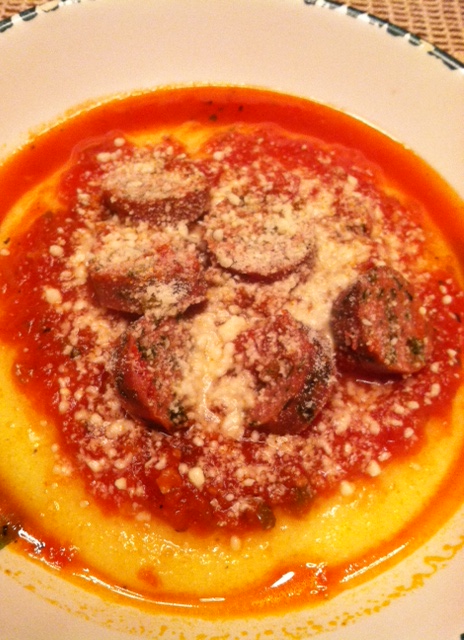
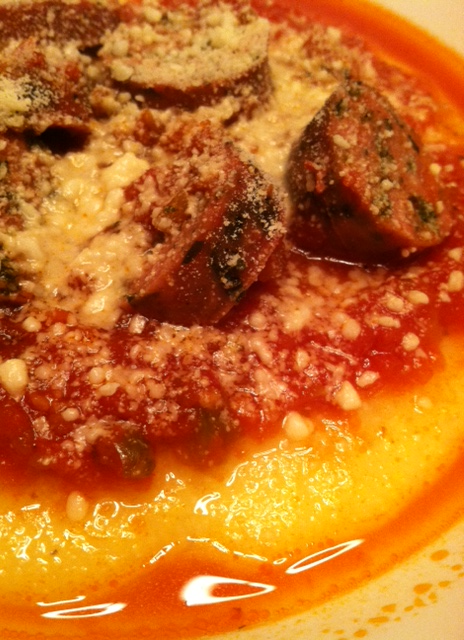
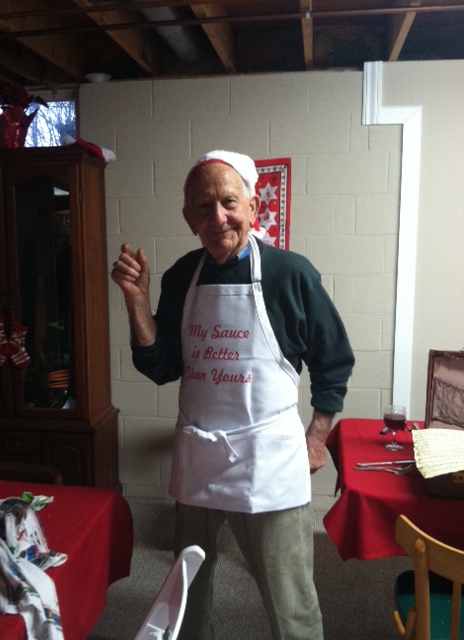


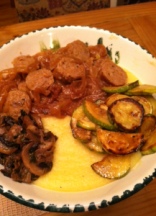
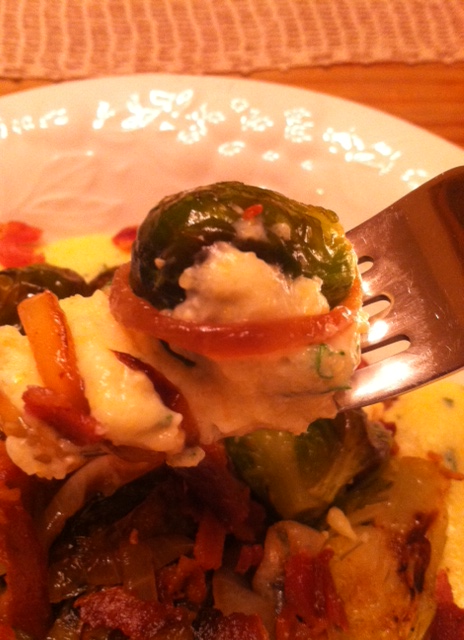
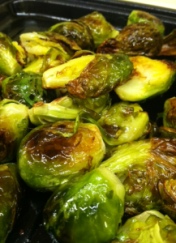



No Comments
Donna Tunno
January 24, 2015 at 6:18 amI woke up early this morning and found this heartwarming blog about Grandpa, Uncle Richard and the story of polenta. I learn so much from your stories and recipes about food and family. What a gift to us and to your readers!
Giovannina Bellino
January 24, 2015 at 7:40 amGreat post Fran, So many of us have a “soft” spot for polenta. I learned how to make it from my husbands 86 year old grandmother, Great Noni. She got mad that I handed her warm water,(should be cold to start, she said) and she broke my wooden spoon stirring it, ( they don’t make them like they used to , she said). Speaking of soft, that’s how I like polenta, not these hockey pucks fried in a pan that you get in most restaurants. Great Noni turned it out of the pot onto a greased cutting board, sliced it through in layers with a thread!!! and layered it in a lasagna pan with muenster cheese, marinara sauce and béchamel. Baked like a lasagna, it was the most incredible thing I ever tasted! Great Noni was from Piacenza, Italy so there is a Swiss/French influence in her cooking.
Ciao, Bella
Fran Tunno
January 24, 2015 at 1:50 pmOh My God! Giovannina, that sounds incredible. I wish you lived close, we could cook together! One day when I’m retired and have the time, I will try that recipe. it sounds amazing. I also love polenta soft, like cream of wheat — you are right, who needs a hockey puck? Thanks so much for reading!
Diane Finley
January 24, 2015 at 12:40 pmFran, we must been really poor because I can never remember my grandmother or mother making polenta. I’m definitely going to try your recipe because if you’re Italian , you must try it at least once! Love ya
Fran Tunno
January 24, 2015 at 1:52 pmWow, below polenta poverty! That’s impressive. Let me know how it turns out! And thanks, as always for reading and your wonderful comments!
Fran Tunno
January 24, 2015 at 1:47 pmOk, I love you. There I said it. Flatter me and I am putty in your hands. I am so glad you feel that way. I will keep trying to make it interesting!
Mary
January 24, 2015 at 6:10 pmYou make it look & sound good Fran, but honestly, I never really liked polenta. I always thought it needed a lot of doctoring up, then it was “okay.” Dad really DID get to be a decent cook after Mom went to her home in the sky & Uncle Richard, . . . . . . it seems like he can make anything taste pretty good, . . . .lol. Keep up the excellent stories!
Fran Tunno
January 24, 2015 at 6:34 pmYou’ll have to try mine and then we’ll talk. Thanks for always reading! You are a loyal sister.
NYC Style Cannoli (@nycstylecannoli)
January 25, 2015 at 5:17 amLove this post I just lost my Mom about 2 weeks ago and food was such a big part of our enjoyment being Italian. She loved polenta and so do I , such a great dish to make so many different ways. We went to a local restaurant and they served it to her on a board to eat, that was fun. I will continue her traditions in cooking as best I can, and enjoy polenta for dinner for myself. Just found your site and looking forward to your posts.
Rosemary Nardone
http://www.nycstylelittlecannoli.com
Fran Tunno
January 25, 2015 at 1:10 pmHi Rosemary! I am so glad you found me. I just got off the phone with one of my best friends from college, Malina Nardone! Who knows? You may be related. I am so sorry to hear about your mom. It is one of the most difficult things in life to lose your parent, especially when you’re close and that parent becomes one of your best friends. You have my sincere sympathy and I hope reading my posts helps you get through your days with a smile. You are now part of my family! Welcome.
Denise F.
January 25, 2015 at 9:42 amFran, you are spot on about trying to get an exact recipe from an Italian. Nobody in my family cooked from recipes. Thank god for my mom, who as a professional cook, has dedicated herself to putting our family recipes on paper. She’s created quite a legacy to pass on. Rotisserie eels?!
Fran Tunno
January 25, 2015 at 4:20 pmHi Denise, yes, on Christmas Eve, he cooked eels in the rotisserie with lemon and possibly butter. I tasted them once, they tasted very fishy to me, so I wasn’t a big fan, but don’t judge eels based on my childhood opinion. You are another lucky one that your mom’s legacy in food is all written down!
Nancy
January 25, 2015 at 4:09 pmHi my dad made his famous polenta last weekend and of course it tasted great I always believed it’s all in sauce and of course my dads sauce is the best I’m sure he will be honored when he finds you wrote about him. Thanks for the article.
Fran Tunno
January 25, 2015 at 4:18 pmOne of these days I’m going to squeeze that sauce recipe out of him, but for now I’ll try to create it on my own. I love your dad, he is simply the best, you are a very lucky girl!
Nicol Zanzarella
January 25, 2015 at 10:06 pmFrenzie, you makin’ me hangry…
So happy to see new followers for you and always love thinking about my family back home while reading about yours!
Fran Tunno
January 25, 2015 at 11:08 pmWell, you’re part of the family now too. That’s how I feel!
Matilda Novak
January 27, 2015 at 9:29 pmi’m among the last, as ever, to read and reply….All i can say is, these all sound Amazing! And, i’m more convinced than ever that Hungarians and Italians are related: We both talk with our hands, Love to Eat, and my Mama is an incredible “instinct cook”…..though she can cough up an actual recipe when pressed.
Fran Tunno
January 28, 2015 at 10:06 amOh Matilda, that you go to the trouble to read the blog is what thrills me. Thank you for always reading and if the stories and recipes ring true, then perfect! I believe we are all far more similar than we are different!